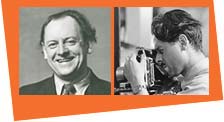Home (The Foundation) - Artist biographies - Ernst Schwitters
Page 1 | 2
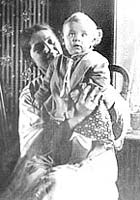 1918
1918
Ernst Eduard Friedrich Schwitters is born in Hanover on 16 November.
1923/24
He spends a great deal of time with his father in his studio, making his first drawings and collages, which his father signs for him. Kate Steinitz refers to the precocious young boy as “his father’s grandfather”. His mother Helma calls him “Ernstlemann”, a nickname his father transforms into “Ernst Lehmann”.
1925
Enrolled in elementary school after Easter.
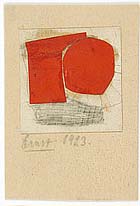 1927
1927
Receives his first camera from his paternal grandfather, an Agfa bellows camera with 9 x 12 cm glass-plate negatives.
1929
Attends secondary school until 1934. Makes his first journey to Norway with his parents, a cruise to western and northern Norway. Ernst is permitted to set up a darkroom in the bathroom of the family’s home on Waldhausenstrasse in Hanover. After a visit by Man Ray, he produces his first photograms together with his father. He continues to experiment with photograms until 1937.
1930
Ernst takes his first summer vacation in Norway, where he is profoundly impressed by the Norwegian landscape and announces that he wants to move to Norway. As Ernst Schwitters later recalls, he takes part in a photo exhibition in Prague, followed by participations in international exhibitions, including shows in Switzerland and Japan, through the 1930s.
1931
Exhibits in the show window of the Lill photography shop in Hanover. His large prints are made here, as his own darkroom is too small. Travels with his parents to Guernsey, Brittany, Madeira, southern Spain, Morocco, and Italy in March and April. Schwitters takes numerous holiday photos with a new Zeiss Ikon medium format camera.
1932
The family travels to Norway and rents a stone cabin on the coastal island of Hjertøya near Molde. In the 1930s, the Schwitters regularly spend their summer holidays on this island or in Djupvasshytta, near Geiranger.
1933
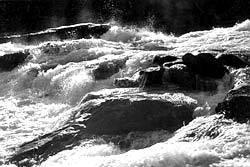 Schwitters
presents six landscape photographs, including several taken in Misburg-Anderten
near Hanover in August 1932, at the "Deuxième Exposition Internationale
de la Photographie et du Cinéma", at the Palais des Beaux-Arts
in Brussels, in June and July. Kurt Schwitters also exhibits four photograms
and a still life at this show.
Schwitters
presents six landscape photographs, including several taken in Misburg-Anderten
near Hanover in August 1932, at the "Deuxième Exposition Internationale
de la Photographie et du Cinéma", at the Palais des Beaux-Arts
in Brussels, in June and July. Kurt Schwitters also exhibits four photograms
and a still life at this show.
Ernst Schwitters is given a Leica 35-millimetre camera by his father. His own work is influenced above all by his father’s ideas about art and by the works of Albert Renger-Patzsch and László Moholy-Nagy. Cruise to Svalbard.
1934
Ernst leaves school in the autumn in reaction to the increasing pressure on students to join the Hitler Youth. His father encourages him to undergo formal training in photography, but he refuses, preferring to teach himself.
Assists his father on commercial advertising commissions. Joins the Socialist Workers Youth (Sozialistische Abeiterjugend, SAJ), a young socialist resistance group, and takes on assignments as a courier. He spends much of the year in Norway, mostly in Oslo, where he meets Eirik Simonsen, the owner of a photography firm.
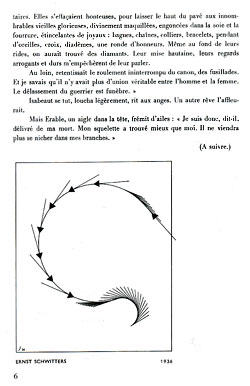 1936
1936
Spends most of the year in Norway. During the summer, he learns that the SAJ groups have been broken up by the police and that many members have been arrested. Heeding his mother’s advice, he postpones his return journey until the late autumn. He travels to Stockholm, where he takes photographs for the Luma factories, before moving on to Copenhagen. He arrives in Hanover in late October. Realizing that he could be arrested under the new laws enacted by the Nazi regime, he decides to return to Norway. He leaves Germany from Hamburg on 26 December.
1937-1939
Kurt Schwitters follows his son on 2 January 1937. They rent an apartment in Lysaker near Oslo. Their efforts to have themselves registered as political refugees fail. They are given residence visas but are not permitted to work. Ernst meets the artist and advertising expert Olav Strømme, who runs an advertising agency, SS-UNU-FOTO, along with two other colleagues. Ernst carries out photo assignments for the agency, which finances his cost of living.
The firm provides Ernst Schwitters with a studio at their address at Kongens gate 23. He produces postcard albums for sale to tourists. Olav Strømme is a frequent guest in Lysaker, although he and others have been advised - by the German exile artist Rolf Nesch, among others - to avoid contact with Schwitters, who is alleged to be in touch with members of the German Embassy staff.
László Moholy-Nagy invites Ernst Schwitters to exhibit his photograms at The New Bauhaus - American School of Design in Chicago. The pictures are sent off, but their ultimate fate is unclear. One of them, Arabian Eight, reappears after the war bearing the signature of the American photographer Arthur Siegel.
Schwitters undertakes frequent camping trips by bicycle through Norway, stopping at favourite spots in Dovrefjell in the Dovre Mountains, Sunndalen, the island of Hjertøya/Romsdal, and Djupvasshytta/Jotunheimen. He visits Trondheim at least twice.
In addition to his many landscapes, he also takes a large number of architectural photographs. He produces some non-photographic art as well and exhibits a sculpture under his own name at the annual Høstutstillingen (autumn exhibition) in Oslo (he later recalls exhibiting under a pseudonym there). He takes part in the art exhibition at the major handicrafts and industrial show “Vi kan” (We Can) in Oslo, and documents significant parts of the exhibition for the city of Oslo.
 1939
1939
Schwitters becomes acquainted with Esther Elisabeth Helene Guldahl, who models for him. They are engaged on 21 May and marry on 25 November. Ernst Schwitters assumes the surname Schwitters-Guldahl and signs his pictures as “E-S-G”.
Helma Schwitters visits Kurt and Ernst in Norway. This is the last time her husband and son will see her. Wartime constraints make it difficult to obtain a residence permit. Ernst and Kurt Schwitters fear that they may be deported and therefore explore the possibility of emigrating to another country.
Page 1 | 2
© Kurt and Ernst Schwitters Foundation
 1918
1918 Ernst Eduard Friedrich Schwitters is born in Hanover on 16 November.
1923/24
He spends a great deal of time with his father in his studio, making his first drawings and collages, which his father signs for him. Kate Steinitz refers to the precocious young boy as “his father’s grandfather”. His mother Helma calls him “Ernstlemann”, a nickname his father transforms into “Ernst Lehmann”.
1925
Enrolled in elementary school after Easter.
 1927
1927 Receives his first camera from his paternal grandfather, an Agfa bellows camera with 9 x 12 cm glass-plate negatives.
1929
Attends secondary school until 1934. Makes his first journey to Norway with his parents, a cruise to western and northern Norway. Ernst is permitted to set up a darkroom in the bathroom of the family’s home on Waldhausenstrasse in Hanover. After a visit by Man Ray, he produces his first photograms together with his father. He continues to experiment with photograms until 1937.
1930
Ernst takes his first summer vacation in Norway, where he is profoundly impressed by the Norwegian landscape and announces that he wants to move to Norway. As Ernst Schwitters later recalls, he takes part in a photo exhibition in Prague, followed by participations in international exhibitions, including shows in Switzerland and Japan, through the 1930s.
1931
Exhibits in the show window of the Lill photography shop in Hanover. His large prints are made here, as his own darkroom is too small. Travels with his parents to Guernsey, Brittany, Madeira, southern Spain, Morocco, and Italy in March and April. Schwitters takes numerous holiday photos with a new Zeiss Ikon medium format camera.
1932
The family travels to Norway and rents a stone cabin on the coastal island of Hjertøya near Molde. In the 1930s, the Schwitters regularly spend their summer holidays on this island or in Djupvasshytta, near Geiranger.
1933
 Schwitters
presents six landscape photographs, including several taken in Misburg-Anderten
near Hanover in August 1932, at the "Deuxième Exposition Internationale
de la Photographie et du Cinéma", at the Palais des Beaux-Arts
in Brussels, in June and July. Kurt Schwitters also exhibits four photograms
and a still life at this show.
Schwitters
presents six landscape photographs, including several taken in Misburg-Anderten
near Hanover in August 1932, at the "Deuxième Exposition Internationale
de la Photographie et du Cinéma", at the Palais des Beaux-Arts
in Brussels, in June and July. Kurt Schwitters also exhibits four photograms
and a still life at this show. Ernst Schwitters is given a Leica 35-millimetre camera by his father. His own work is influenced above all by his father’s ideas about art and by the works of Albert Renger-Patzsch and László Moholy-Nagy. Cruise to Svalbard.
1934
Ernst leaves school in the autumn in reaction to the increasing pressure on students to join the Hitler Youth. His father encourages him to undergo formal training in photography, but he refuses, preferring to teach himself.
Assists his father on commercial advertising commissions. Joins the Socialist Workers Youth (Sozialistische Abeiterjugend, SAJ), a young socialist resistance group, and takes on assignments as a courier. He spends much of the year in Norway, mostly in Oslo, where he meets Eirik Simonsen, the owner of a photography firm.
 1936
1936 Spends most of the year in Norway. During the summer, he learns that the SAJ groups have been broken up by the police and that many members have been arrested. Heeding his mother’s advice, he postpones his return journey until the late autumn. He travels to Stockholm, where he takes photographs for the Luma factories, before moving on to Copenhagen. He arrives in Hanover in late October. Realizing that he could be arrested under the new laws enacted by the Nazi regime, he decides to return to Norway. He leaves Germany from Hamburg on 26 December.
1937-1939
Kurt Schwitters follows his son on 2 January 1937. They rent an apartment in Lysaker near Oslo. Their efforts to have themselves registered as political refugees fail. They are given residence visas but are not permitted to work. Ernst meets the artist and advertising expert Olav Strømme, who runs an advertising agency, SS-UNU-FOTO, along with two other colleagues. Ernst carries out photo assignments for the agency, which finances his cost of living.
The firm provides Ernst Schwitters with a studio at their address at Kongens gate 23. He produces postcard albums for sale to tourists. Olav Strømme is a frequent guest in Lysaker, although he and others have been advised - by the German exile artist Rolf Nesch, among others - to avoid contact with Schwitters, who is alleged to be in touch with members of the German Embassy staff.
László Moholy-Nagy invites Ernst Schwitters to exhibit his photograms at The New Bauhaus - American School of Design in Chicago. The pictures are sent off, but their ultimate fate is unclear. One of them, Arabian Eight, reappears after the war bearing the signature of the American photographer Arthur Siegel.
Schwitters undertakes frequent camping trips by bicycle through Norway, stopping at favourite spots in Dovrefjell in the Dovre Mountains, Sunndalen, the island of Hjertøya/Romsdal, and Djupvasshytta/Jotunheimen. He visits Trondheim at least twice.
In addition to his many landscapes, he also takes a large number of architectural photographs. He produces some non-photographic art as well and exhibits a sculpture under his own name at the annual Høstutstillingen (autumn exhibition) in Oslo (he later recalls exhibiting under a pseudonym there). He takes part in the art exhibition at the major handicrafts and industrial show “Vi kan” (We Can) in Oslo, and documents significant parts of the exhibition for the city of Oslo.
 1939
1939 Schwitters becomes acquainted with Esther Elisabeth Helene Guldahl, who models for him. They are engaged on 21 May and marry on 25 November. Ernst Schwitters assumes the surname Schwitters-Guldahl and signs his pictures as “E-S-G”.
Helma Schwitters visits Kurt and Ernst in Norway. This is the last time her husband and son will see her. Wartime constraints make it difficult to obtain a residence permit. Ernst and Kurt Schwitters fear that they may be deported and therefore explore the possibility of emigrating to another country.
Page 1 | 2
© Kurt and Ernst Schwitters Foundation

